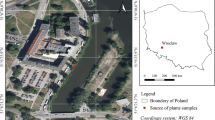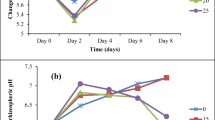Abstract
Lead is a very toxic metal which affects human health. An alternative to remove it from contaminated water is the use of macrophytes, as Scirpus americanus Pers. This species is tolerant to salt and metals and has high biomass. The present research analyzed the capacity of hydroponic cultures of normal and transgenic plants (line T12) from S. americanus to remove high concentrations of lead. The antioxidant response of plants to metal exposure was also measured. The MINTEQ3.1 program was used to define the media composition in order to have the metal available to the plants. According to MINTEQ3.1 predictions, sulfate, phosphate, and molybdenum must be removed from the medium to avoid lead precipitation. Therefore, the plants were maintained in a modified Hoagland solution containing 100, 250, and 400 mg/L lead. The presence of metal did not affect the growth of roots and stems at all concentration tested. The normal and T12 plants accumulated 69,389 mg/kg and 45,297 mg/kg lead, respectively, and could be considered hyperaccumulators. Plant tolerance to lead mainly involved an increase in superoxide dismutase activity and glutathione accumulation. The bioconcentration factor indicated that S. americanus plants bioconcentrated between 192 and 300 times the metal; thus, S. americanus could be used for phytoremediation of water contaminated with a high concentration of lead.





Similar content being viewed by others
Data Availability
Data are available at UASLP repository (URI: https://repositorioinstitucional.uaslp.mx/xmlui/handle/i/7110).
References
Alfaro-Saldaña EF, Pérez-Molphe-Balch E, Santos-Díaz MS (2016) Generation of transformed roots of Scirpus americanus Pers. and study of their potential to remove Pb2+ and Cr3+. Plant Cell Tiss Organ Cult 127:15–24. https://doi.org/10.1007/s11240-016-1025-2
Auguy F, Fahr M, Moulin P, Brugel A, Laplaze L, Mzibri ME., ... Smouni A (2013) Lead tolerance and accumulation in Hirschfeldia incana, a Mediterranean Brassicaceae from metalliferous mine spoils. PLoS One 8(5):e61932. https://doi.org/10.1371/journal.pone.0061932
Blum MJ, Saunders CJ, McLachlan JS, Summers J, Craft C, Herrick JD (2021) A century-long record of plant evolution reconstructed from a coastal marsh seed bank. Evol Letter 5(4):422–431. https://doi.org/10.1002/evl3.242
Bradford MM (1976) A rapid and sensitive method for the quantitation of microgram quantities of protein utilizing the principle of protein-dye binding. Anal Biochem 72:248–254. https://doi.org/10.1016/0003-2697(76)90527-3
Carranza-Álvarez C, Alonso-Castro AJ, Alfaro-De La Torre MC, García-De-La Cruz RF (2008) Accumulation and distribution of heavy metals in Scirpus americanus and Typha latifolia from an artificial lagoon in San Luis Potosí, México. Water Air Soil Pollut 188:297–309. https://doi.org/10.1007/s11270-007-9545-3
CDC. Centers for Disease Control and Prevention. Childhood lead poisoning prevention. Children (2022) Available from: https://www.cdc.gov/nceh/lead/prevention/children.htm. Accessed 23 Oct 2023
Dalyan E, Yüzbaşıoğlu E, Akpınar I (2020) Physiological and biochemical changes in plant growth and different plant enzymes in response to lead stress. In: Gupta DK, Chatterjee S, Walther C (eds) Lead in Plants and the Environment. Springer Cham, pp 129–147
Dinh N, Van der Ent A, Mulligan DR, Nguyen AV (2018) Zinc and lead accumulation characteristics and in vivo distribution of Zn2+ in the hyperaccumulator Noccaea caerulescens elucidated with fluorescent probes and laser confocal microscopy. Environ Exp Bot 147:1–12. https://doi.org/10.1016/j.envexpbot.2017.10.008
Espinoza-Quinones FR, Zacarkim CE, Palacio SM, Obregon CL, Zenatti DC, Galante RM, Rizzutto MDA (2005) Removal of heavy metal from polluted river water using aquatic macrophytes Salvinia sp. Braz J Phys 35:744–746. https://doi.org/10.1590/S0103-97332005000500005
Fahr M, Laplaze L, Bendaou N, Hocher V, Mzibri ME, Bogusz D, Smouni A (2013) Effect of lead on root growth. Front Plant Sci 4:175. https://doi.org/10.3389/fpls.2013.00175
George EF, Somerset M, Hall MA, De Klerk GJ (2008) The components of plant tissue culture media I: macro- and micro-nutrients. Chapter 3. In: Plant propagation by tissue culture, 3rd edn (vol 1). The Background Springer Dordrecht, pp 65–113
Giannopolitis CN, Ries SK (1977) Superoxide dismutases: I. Occurrence in higher plants. Plant Physiol 59:309–314. https://doi.org/10.1104/pp.59.2.309
He W, Wang S, Wang Y, Lu M, Shi X (2023) Pathways and characteristics of lead uptake and transportation in Rhus chinensis Mill. Forests 14(1):90. https://doi.org/10.3390/f14010090
Hoagland DR, Arnon DI (1950) The water culture method for growing plants without soil. Calif Agric Exp Stn Circ 347:1–32
Hodges DM, Forney CF, Wismer WV (2001) Antioxidant responses in harvested leaves of two cultivars of spinach differing in senescence rates. J Am Soc Hort Sci 126:611–617. https://doi.org/10.21273/JASHS.126.5.611
Hou Y, Hou Y, Liu X, Zhang X, Chen X, Tao K, Liang X, He C (2015) Identification of Scirpus triqueter root exudates and the effects of organic acids on desorption and bioavailability of pyrene and lead in co-contaminated wetland soils. Environ Sci Pollut Res 22:17780–17788. https://doi.org/10.1007/s11356-015-4995-4
Janousek CN, Dugger BD, Drucker BM, Thorne KM (2020) Salinity and inundation effects on productivity of brackish tidal marsh plants in the San Francisco Bay-Delta Estuary. Hydrobiol 847:4311–4323. https://doi.org/10.1007/s10750-020-04419-3
Khalid S, Shahid M, Alothman ZA, Al-Kahtani AA, Murtaza B, Dumat C (2023) Predicting chemical speciation of metals in soil using Visual Minteq. Soil Ecol Lett 5:220162. https://doi.org/10.1007/s42832-022-0162-2
Kocaman A (2023) Combined interactions of amino acids and organic acids in heavy metal binding in plants. Plant Signal Behav 18:2064072. https://doi.org/10.1080/15592324.2022.2064072
Kopittke PM, Asher CJ, Blamey FP, Auchterlonie GJ, Guo YN, Menzies NW (2008) Localization and chemical speciation of Pb in roots of signal grass (Brachiaria decumbens) and Rhodes grass (Chloris gayana). Environ Sci Tech 42:4595–4599. https://doi.org/10.1021/es702627c
Kumar A, Prasad MNV (2018) Plant-lead interactions: transport, toxicity, tolerance, and detoxification mechanisms. Ecotoxicol Environ Saf 166:401–418. https://doi.org/10.1016/j.ecoenv.2018.09.113
Kushwaha A, Hans N, Kumar S, Rani R (2018) A critical review on speciation, mobilization and toxicity of lead in soil-microbe-plant system and bioremediation strategies. Ecotoxicol Environ Saf 147:1035–1045. https://doi.org/10.1016/j.ecoenv.2017.09.049
Luo ZB, He J, Polle A, Rennenberg H (2016) Heavy metal accumulation and signal transduction in herbaceous and woody plants: paving the way for enhancing phytoremediation efficiency. Biotech Adv 34:1131–1148. https://doi.org/10.1016/j.biotechadv.2016.07.003
Montante-Montelongo AD, Alfaro-de la Torre MC, Medellín-Milán P (1995) Estudio geoquímico de elementos traza en una laguna artificial de aguas residuales. Actas INAGEQ 1:33–38
Murashige T, Skoog F (1962) A revised medium for rapid growth and bio assays with tobacco tissue cultures. Physiol Plant 15:473–497. https://doi.org/10.1111/j.1399-3054.1962.tb08052.x
Nareshkumar A, Krishnappa BV, Kirankumar TV, Kiranmai K, Lokesh U, Sudhakarbabu O, Sudhakar C (2014) Effect of Pb-stress on growth and mineral status of two groundnut (Arachis hypogaea L.) cultivars. J Plant Sci 2:304–310. https://doi.org/10.11648/j.jps.20140206.17
Reeves RD (2006) Hyperaccumulation of trace elements by plants. Phytoremediation of metal-contaminated soils. Springer, Netherlands, Dordrecht, pp 25–52
Santiago R, Fontaniella B, Vicente C (2009) Guión de prácticas de la asignatura Fisiopatología Vegetal. REDUCA (Biología) 2(3):146–166
Santos-Díaz MS, Barrón-Cruz MC (2011) Lead, chromium and manganese removal by in vitro root cultures of two aquatic macrophytes species: Typha latifolia L. and Scirpus americanus Pers. Int J Phytorem 13:538–551. https://doi.org/10.1080/15226511003671379
Santos-Díaz MS, Barrón-Cruz MC, Alfaro-de la Torre MC (2007) Induction of in vitro roots cultures of Thypha latifolia and Scirpus americanus and study of their capacity to remove heavy metals. Electron J Biotech 10:417–424. https://doi.org/10.4067/S0717-34582007000300009
Sharma JK, Kumar N, Singh NP, Santal AR (2023) Phytoremediation technologies and their mechanism for removal of heavy metal from contaminated soil: an approach for a sustainable environment. Front Plant Sci 14:1076876. https://doi.org/10.3389/fpls.2023.1076876
Singh C, Singh R, Shekhar A (2023) Antioxidant defense: a key mechanism of lead tolerance. Lead toxicity: challenges and solution. Springer Nature Switzerland, Cham, pp 127–144
Song WY, Park J, Eisenach C, Maeshima M, Lee Y, Martinoia E (2014) ABC transporters and heavy metals. In: Geisler M (ed) Plant ABC Transporters. Signaling and Communication in Plants (vol 22). Springer Cham, pp 1–17
Srivastava P (2023) Recent trends in biomining microorganisms for solid waste management. Microbial technology for sustainable E-waste management. Springer International Publishing, Cham, pp 273–286
Steiner AA (1966) The influence of the chemical composition of a nutrient solution on the production of tomato plants. Plant Soil 24:454–466. https://doi.org/10.1007/BF01374052
Takarina ND, Pin TG (2017) Bioconcentration factor (BCF) and translocation factor (TF) of heavy metals in mangrove trees of Blanakan fish farm. Makara J Sci 21:77–81. https://doi.org/10.7454/mss.v21i2.7308
Usman K, Abu-Dieyeh MH, Zouari N, Al-Ghouti MA (2020) Lead (Pb) bioaccumulation and antioxidative responses in Tetraena qataranse. Sci Rep 10:17070. https://doi.org/10.1038/s41598-020-73621-z
Venkatachalam P, Jayalakshmi N, Geetha N, Sahi SV, Sharma NC, Rene ER, Favas PJ (2017) Accumulation efficiency, genotoxicity and antioxidant defense mechanisms in medicinal plant Acalypha indica L. under lead stress. Chemosphere 171:544–553. https://doi.org/10.1016/j.chemosphere.2016.12.092
Wang Y, Zhong B, Shafi M, Ma J, Guo J, Wu J, Yea Z, Liua D, Jin H (2019) Effects of biochar on growth, and heavy metals accumulation of moso bamboo (Phyllostachy pubescens), soil physical properties, and heavy metals solubility in soil. Chemosphere 219:510–516. https://doi.org/10.1016/j.chemosphere.2018.11.159
Wang L, Ma C, Jia X, Dou Z, Wang H, Dong M, ... Zhang Y (2023) Oxic effects of Pb-Ce compound pollution on Chinese cabbage and programmed cell death in root tip cells. Chemosphere 328:138520. https://doi.org/10.1016/j.chemosphere.2023.138520
WHO (2022) Lead poisoning. https://www.who.int/news-room/fact-sheets/detail/lead-poisoning-and-health. Accessed 31 Aug 2022
Wilkinson SR, Naeth MA, Dhar A (2023) Potential of macrophytes for wastewater remediation with constructed floating wetlands in cold climates. Water 15:2479. https://doi.org/10.3390/w15132479
Xu T, Lin K, Cao M, Miao X, Guo H, Rui D, ... Yan Y (2023) Patterns of global burden of 13 diseases attributable to lead exposure, 1990–2019. BMC Public Health 23:1–14. https://doi.org/10.1186/s12889-023-15874-7
Yang J, Ye Z (2015) Antioxidant enzymes and proteins of wetland plants: Their relation to Pb tolerance and accumulation. Environ Sci Pollut Res 22:1931–1939. https://doi.org/10.1007/s11356-014-3610-4
Acknowledgements
The authors thank “Consejo Nacional de Ciencia y Tecnología” (CONACYT) for the scholarship to EER (2018-000012-01NACF-0150), and to Estela Nuñez for her technical assistance.
Funding
This work was supported by “Fondo de Apoyo a la Investigación” FAI-UASLP (grant C18-FAI-05–68.6).
Author information
Authors and Affiliations
Contributions
Esquivel-Ramos E realized the experimental work and participated on elaboration of figures and revision of manuscript. Alfaro-de la Torre MA participated in media formulation using the MINTEQ3.1 program and revision and discussion of results. Santos-Díaz MS is the leader of the group, designed the project and experimental work, participated in revision and discussion, and wrote the paper.
Corresponding author
Ethics declarations
Ethical approval
No animals or persons were used in this work.
Consent to participate
Esquivel-Ramos E, Alfaro-de la Torre MA, and Santos-Díaz MS gave their consent to participate in this paper.
Consent for publication
Esquivel-Ramos E, Alfaro-de la Torre MA, and Santos-Díaz MS gave their consent for the publication of this paper.
Competing interests
The authors declare no competing interests.
Additional information
Responsible Editor: Elena Maestri
Publisher's Note
Springer Nature remains neutral with regard to jurisdictional claims in published maps and institutional affiliations.
Rights and permissions
Springer Nature or its licensor (e.g. a society or other partner) holds exclusive rights to this article under a publishing agreement with the author(s) or other rightsholder(s); author self-archiving of the accepted manuscript version of this article is solely governed by the terms of such publishing agreement and applicable law.
About this article
Cite this article
Esquivel-Ramos, E., Alfaro-de la Torre, M.C. & Santos-Díaz, M.d.S. Removal of high lead concentration by hydroponic cultures of normal and transformed plants of Scirpus americanus Pers.. Environ Sci Pollut Res 31, 28279–28289 (2024). https://doi.org/10.1007/s11356-024-33051-0
Received:
Accepted:
Published:
Issue Date:
DOI: https://doi.org/10.1007/s11356-024-33051-0




